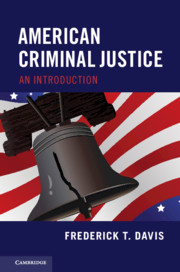Book contents
- American Criminal Justice
- American Criminal Justice
- Copyright page
- Dedication
- Contents
- Acknowledgments
- 1 Introduction
- 2 The Federal Structure; Sources of the Law
- 3 Investigation and Evidence-Gathering—The Participants
- 4 Investigation and Evidence-Gathering—Procedures
- 5 Arrest and Pretrial Detention
- 6 The Decision to Prosecute, or Not
- 7 Joinder of Charges and Defendants
- 8 Venue
- 9 Assistance of Counsel
- 10 Trial Rights and Preparation for Trial
- 11 Alternative Outcomes
- 12 Double Jeopardy
- 13 The Trial
- 14 Sentencing
- 15 Appeals
- 16 Corporate Criminal Responsibility
- 17 Internal Corporate Investigations
- 18 Professional Responsibility
- 19 Conclusion
- Bibliography
- Index
7 - Joinder of Charges and Defendants
Published online by Cambridge University Press: 08 June 2019
- American Criminal Justice
- American Criminal Justice
- Copyright page
- Dedication
- Contents
- Acknowledgments
- 1 Introduction
- 2 The Federal Structure; Sources of the Law
- 3 Investigation and Evidence-Gathering—The Participants
- 4 Investigation and Evidence-Gathering—Procedures
- 5 Arrest and Pretrial Detention
- 6 The Decision to Prosecute, or Not
- 7 Joinder of Charges and Defendants
- 8 Venue
- 9 Assistance of Counsel
- 10 Trial Rights and Preparation for Trial
- 11 Alternative Outcomes
- 12 Double Jeopardy
- 13 The Trial
- 14 Sentencing
- 15 Appeals
- 16 Corporate Criminal Responsibility
- 17 Internal Corporate Investigations
- 18 Professional Responsibility
- 19 Conclusion
- Bibliography
- Index
Summary
American criminal justice places a high value on judicial economy. As a result, the Federal Rules of Criminal Procedure permit prosecutors to join offenses and defendants in a single indictment or (where applicable) information, see Chapter 6.C. A case may thus proceed to trial with several defendants and may include several different charged offenses.
An indictment or information will typically list one or more counts, which are the specific charges against the defendants; each count must allege a specific, separate violation of one specific criminal law. Rule 8 of the Federal Rules of Criminal Procedure provides that an “indictment or information may charge a defendant in separate counts with two or more offenses if the offenses charged—whether felonies or misdemeanors or both—are of the same or similar character, or are based on the same act or transaction, or are connected with or constitute parts of a common scheme or plan.” The indictment or information may also “charge two or more defendants if they are alleged to have participated in the same act or transaction, or in the same series of acts or transactions, constituting an offense or offenses. The defendants may be charged in one or more counts together or separately. All defendants need not be charged in each count.”
- Type
- Chapter
- Information
- American Criminal JusticeAn Introduction, pp. 49 - 50Publisher: Cambridge University PressPrint publication year: 2019



